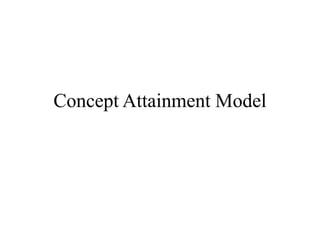Concept attainment model
•
2 likes•2,951 views
elements of concept attainment model
Report
Share
Report
Share

Recommended
Recommended
More Related Content
What's hot
What's hot (20)
CHEM Study and CBA : Salient features, merits and demerits

CHEM Study and CBA : Salient features, merits and demerits
Knowledge - Concept, Nature, Steps & Importance of Knowledge

Knowledge - Concept, Nature, Steps & Importance of Knowledge
Proffessional qualities and competencies of mathematics teacher

Proffessional qualities and competencies of mathematics teacher
Similar to Concept attainment model
Similar to Concept attainment model (20)
modelsofteaching-120122073945-phpapp01-140222111541-phpapp02.pdf

modelsofteaching-120122073945-phpapp01-140222111541-phpapp02.pdf
combined qualitative & quanttaitive research design (2).pptx

combined qualitative & quanttaitive research design (2).pptx
Recently uploaded
https://app.box.com/s/7hlvjxjalkrik7fb082xx3jk7xd7liz3TỔNG ÔN TẬP THI VÀO LỚP 10 MÔN TIẾNG ANH NĂM HỌC 2023 - 2024 CÓ ĐÁP ÁN (NGỮ Â...

TỔNG ÔN TẬP THI VÀO LỚP 10 MÔN TIẾNG ANH NĂM HỌC 2023 - 2024 CÓ ĐÁP ÁN (NGỮ Â...Nguyen Thanh Tu Collection
Recently uploaded (20)
Interdisciplinary_Insights_Data_Collection_Methods.pptx

Interdisciplinary_Insights_Data_Collection_Methods.pptx
21st_Century_Skills_Framework_Final_Presentation_2.pptx

21st_Century_Skills_Framework_Final_Presentation_2.pptx
Simple, Complex, and Compound Sentences Exercises.pdf

Simple, Complex, and Compound Sentences Exercises.pdf
Python Notes for mca i year students osmania university.docx

Python Notes for mca i year students osmania university.docx
TỔNG ÔN TẬP THI VÀO LỚP 10 MÔN TIẾNG ANH NĂM HỌC 2023 - 2024 CÓ ĐÁP ÁN (NGỮ Â...

TỔNG ÔN TẬP THI VÀO LỚP 10 MÔN TIẾNG ANH NĂM HỌC 2023 - 2024 CÓ ĐÁP ÁN (NGỮ Â...
PANDITA RAMABAI- Indian political thought GENDER.pptx

PANDITA RAMABAI- Indian political thought GENDER.pptx
Introduction to TechSoup’s Digital Marketing Services and Use Cases

Introduction to TechSoup’s Digital Marketing Services and Use Cases
Transparency, Recognition and the role of eSealing - Ildiko Mazar and Koen No...

Transparency, Recognition and the role of eSealing - Ildiko Mazar and Koen No...
HMCS Max Bernays Pre-Deployment Brief (May 2024).pptx

HMCS Max Bernays Pre-Deployment Brief (May 2024).pptx
Concept attainment model
- 2. Concept Attainment Model • Designed to help students learn concepts for organising information and to help students become more effective at learning concepts. • Based on the assertion that human beings have the inherent capacity to discriminate and categorize things into group.
- 3. • Concept – Concept is a mental representation or mental picture of some objects or experience. – Represents a category of objects which share common properties. – “A concept is simply a label of a set of things that something in common.” - Archer (1969)
- 4. • Elements of a concept 1. Name : it is the term or label given to a concept 2. Attributes : features or characteristics of objects – Essential Attributes: common features of the concepts • Should be present in all the examples • Removal of this will change the concept
- 5. • Non- essential attributes – Attributes which are not essential for a concept – Removal of this will not change the concept. • Example • Concept : Triangle • Essential attribute – Closed geometrical figures, three sides, three angles • Non- essential attribute – Length of the sides, measures of angles, colour
- 6. 3. Examples – Positive examples – Negative examples
- 7. Concept Attainment Model • Name of the concept • Definition of the concept • Essential attributes • Non-essential attributes • Positive examples • Negative examples
- 8. • Focus – To help students learn concepts for organising information and to help students become more effective at learning concepts.
- 9. • Syntax – Phase I: Presentation of Data and Identification of concept – Phase II: Testing Attainment of the concept – Phase III: Analysis of Thinking strategies
- 10. Phase I: Presentation of Data and Identification of concept • Introduction • Presentation of examples – Teacher presents labelled examples • Comparison of attributes – Students compare attributes in positive and negative examples
- 11. • Generating and testing hypothesis – Students generate and test hypotheses • Naming the concept – Students state a definition according to the essential attributes
- 12. Phase II: Testing Attainment of the concept • Teacher tests the concepts attained by the students using the following techniques – Students identify additional unlabelled examples as ‘yes’ or ‘no’ – Teacher restate definitions according to the essential attributes – Students generate own examples
- 13. Phase III: Analysis of Thinking strategies • Students describe thoughts. • Students discuss role of hypotheses and attributes. • Students discuss type and number of hypotheses. • Evaluating the strategies.
- 14. • Social System – Moderate structure – Students interaction is encouraged – Freedom to students for generating hypothesis • Principle of Reaction – Teacher act as a supporter and motivate students in designing the hypothesis formulation. – Students discuss and evaluate their thinking strategies with proper assistance of the teacher
- 15. • Support System – Creative learning environment for attaining concepts and active participation. – Appropriate examples , non examples and organised materials
- 16. • Instructional Effect – Students learn clear idea about the concept – They get practice in inductive reasoning – Get opportunities to improve concept building strategies
- 17. • Nurturant Effect – Sensitivity to logical reasoning in communication – Tolerance – Awareness of alternative perspectives
- 18. Advantages • It develops the reasoning power of the students. • It helps in developing the power of imagination • Helps in analyzing things systematically • Helps students to examine a concept from a number of perspectives. • Helps to learn how to sort out relevant information.